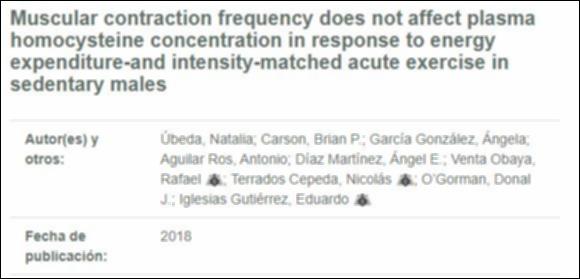Por favor, use este identificador para citar o enlazar este ítem:
http://hdl.handle.net/10637/14940Muscular contraction frequency does not affect plasma homocysteine concentration in response to energy expenditure- and intensity-matched acute exercise in sedentary males
| Título : | Muscular contraction frequency does not affect plasma homocysteine concentration in response to energy expenditure- and intensity-matched acute exercise in sedentary males |
| Autor : | Úbeda Martín, Natalia Carson, Brian P García González, Ángela Aguilar Ros, Antonio Díaz Martínez, Ángel Enrique Venta, Rafael Terrados, Nicolás O'Gorman, Donal J. Iglesias Gutiérrez, Eduardo |
| Materias: | Cinétique de l’homocystéine; Exercise prescription; Frequency of contraction; Fréquence des contractions; Homocysteine kinetics; Prescription d’exercices |
| Editorial : | Canadian Science Publishing |
| Citación : | Úbeda N, Carson BP, García-González Á, Aguilar-Ros A, Díaz-Martínez ÁE, Venta R, Terrados N, O Gorman DJ, Iglesias-Gutiérrez E. Muscular contraction frequency does not affect plasma homocysteine concentration in response to energy expenditure and intensity matched acute exercise in sedentary males. Appl Physiol Nutr Metab. 2018; 43(2): 107-112. |
| Resumen : | Acute exercise seems to increase total plasma homocysteine (tHcy); since this variable associated with cardiovascular risk, it is important to understand the determinants of its response to all types of exercise. The aim of this study was to examine the impact of cycling at 2 different rates of muscle contraction on the complete tHcy kinetics. Eight young sedentary males were required to complete 2 isocaloric (400 kcal) acute exercise trials at 50% peak oxygen uptake on separate occasions at 50 or 80 rpm. Blood samples were drawn at different points before (4 h before exercise and immediately before exercise), during (10, 20, 30, 45, and 60 min during exercise), and after exercise (immediately and 19 h after exercise). Dietary and lifestyle factors were controlled during the research. Maximum tHcy occurred during exercise for both conditions (50 rpm: 11.4 ± 2.7 μmol·L-1; 80 rpm: 10.8 ± 3.2 μmol·L-1). From this point onwards tHcy declined until the cessation of exercise and continued descending below pre-exercise values at 19 h postexercise (p < 0.05). No hyperhomocysteinemia were observed at any sampling point in both trials. In conclusion, the different muscular contraction frequency during exercise has no impact on tHcy during an acute bout of exercise in sedentary individuals, when at least 400 kcal are spent during exercise and the nutritional status for folate, B12, and B6 is adequate. This information is relevant to further inform healthy exercise prescription, not only in terms of duration and intensity of exercise, but also taking into account frequency of contraction. |
| URI : | http://hdl.handle.net/10637/14940 |
| Derechos: | http://creativecommons.org/licenses/by/4.0/deed.es |
| ISSN : | 1715-5320 |
| Fecha de publicación : | feb-2018 |
| Centro : | Universidad San Pablo-CEU |
| Aparece en las colecciones: | Facultad de Farmacia |
Los ítems de DSpace están protegidos por copyright, con todos los derechos reservados, a menos que se indique lo contrario.


